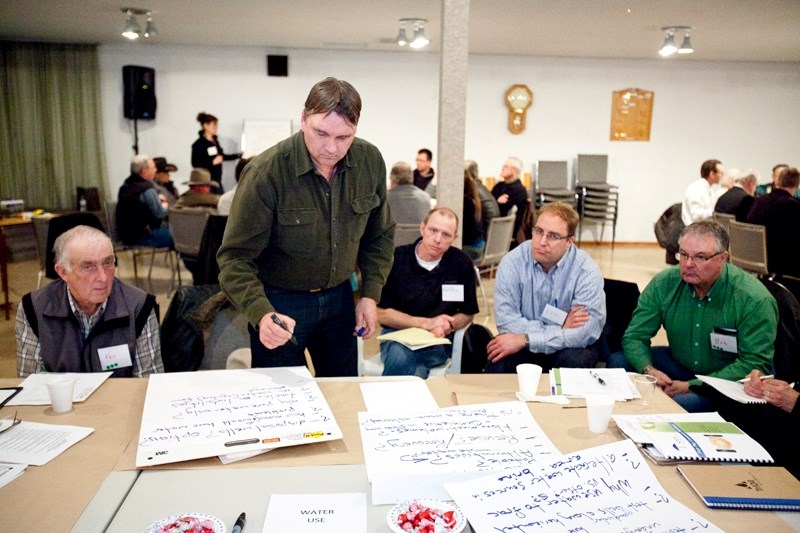People from at least four rural Alberta counties packed the Harmattan Community Hall last week to find acceptable ways for oil and gas well fracking to occur in the West Central Alberta area, as opposed to finding ways to stop it.The process of using fluids and proppants to break apart low-permeability deep underground rock so oil and gas flows to wells for collection, has raised many concerns including the potential for water contamination.Several calls for a provincewide moratorium on the controversial drilling practice have been made since hydraulic fracking was implicated in a Jan. 13 Gleniffer Lake area well blowout.But that was not the topic at hand in Harmattan on Feb. 13, said meeting facilitator Tracey McCrimmon.ìI did not hear calls for the end to fracking,î said. McCrimmon. ìWe have concerns but no, we don't want industry to pack up and go away.îInstead of trying to end the practice, the more than 100 people gathered at the hall were tasked with giving input into a made-in-West-Central-Alberta solution to bridge the gap between where fracking regulations leave off and the higher expectations of other stakeholders, including landowners.The largely invitation-only meeting ñ attended by oil and gas company representatives, municipal politicians, landowners, and provincial government energy regulators ñ kicked off what organizers are calling a Proactive Engagement Process.ìThe tangible end result is that we're going to create a list of performance measures that the community approves of that's above and beyond the minimum requirements,î McCrimmon said.The hope is that companies operating in the West Central Alberta area will voluntarily use the best practices.Leading the charge is the Sundre Petroleum Operators Group (SPOG), of which McCrimmon is the executive director. SPOG hosted the Harmattan meeting and will lead the consultation process over the next few months.The group has acted as the liaison between oil and gas companies and landowners in the counties of Red Deer, Clearwater, Mountain View and Big Horn for 20 years.SPOG's area covers 600 square miles and is bordered by Highway 54 in the north, Highway 582 in the south, Highway 766 in the east, and between ranges 7 and 8 in the west.Issues surrounding the government regulated industry practice of hydraulic fracking have been brewing in the area for years, said McCrimmon.Prior to Wild Stream exploration's well blowout in Red Deer County in January, she said SPOG was already putting in place the framework for how to get consensus in its area on acceptable fracking practices.It's an approach that has worked well for the group in the past, said McCrimmon.SPOG was created in 1992 from an industry effort to accommodate the community's desire for a coordinated emergency response plan.Over the years it has helped resolve industry and landowner disputes as well as enact voluntary best practices in the area such as no rig moves during school bus hours.Since the mid to late 2000s, hydraulic fracturing, multi-stage and horizontal drilling have become commonplace in the area because it has allowed companies to access oil and gas they were unable to reach with conventional methods.McCrimmon estimates 75 per cent of the 370-some wells drilled in SPOG's 600 square mile area in 2011 were fracked.She said she expects a similar amount of activity in 2012.As long as future meetings meet with as much success as the Harmattan one did, McCrimmon said it's possible to pilot SPOG's best practices for fracking by this summer.Specific concerns were gathered from participants around water use, groundwater aquifers, traffic, flaring, noise and light, notification, and adequate consultation during round-table exercises.Many of the concerns expressed during discussions on water related to non-disclosure of how much water is used in the fracturing process and whether aquifers are being negatively impacted.ìOil and gas companies should have to disclose publicly all water withdrawals, where the water is used and how much flow-back is generated,î said Mountain View County councillor Paddy Munro, reading off a list of 12 written concerns.Red Deer County landowner Glenn Norman also voiced a host of water-related concerns.ìI would like to see the use of tracer chemicals in freshwater aquifers as a way to determine where chemicals are coming from.îOthers wanted public disclosure of the fluids used in the fracturing process.ìBenzene, tylene...Some of this stuff, it'll make your hair curl if you knew about it,î said an area landowner.Another participant who identified herself simply as a concerned citizen, voiced concerns with intensity and density of wells having the potential to create further fractures in the earth and minor earthquakes.Information from the meeting will be prioritized and working committees are expected to further hammer out details.They won't be reinventing the wheel, says McCrimmon, but rather they will be using tools such as the Canadian Association of Petroleum Producers (CAPP) guiding principles on fracking to conduct gap analysis.ìI would say there's going to be gaps,î she said.



